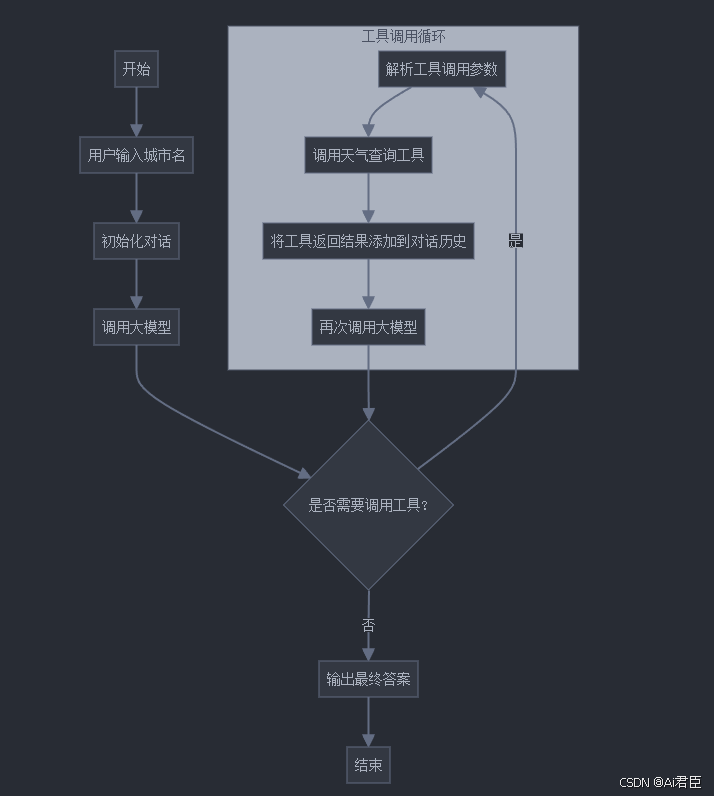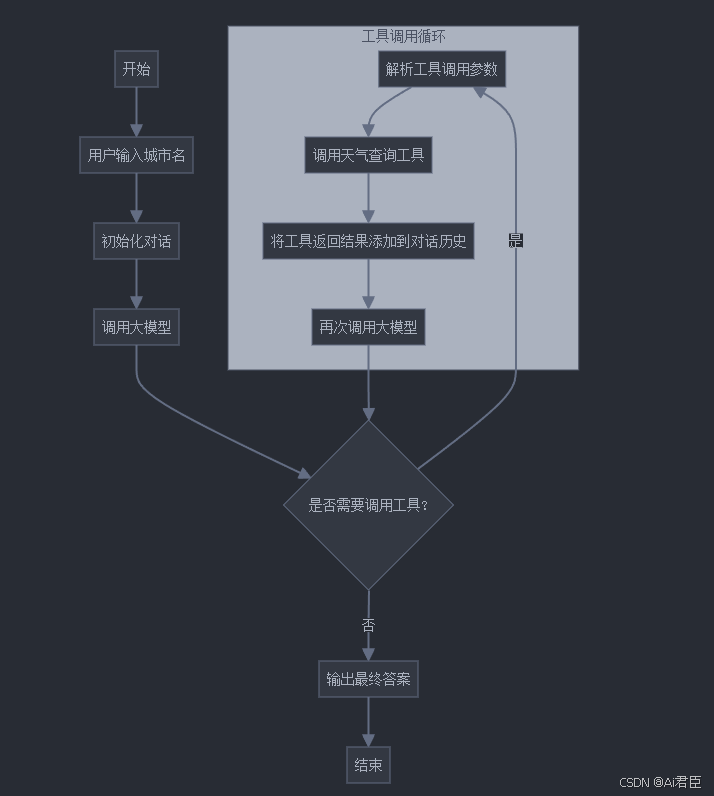【理解工具调用的流程,本质体现了大模型智能性】
1、工具调用
调用完结果看里面tool_calls 是否为空,不为空就调用工具函数处理,
如果为空就中断循环。大模型返回的message结果智能判断是否继续调用

输入输出如下:
请输入:深圳西安天气
------------------------------------------------------------
第1轮大模型输出信息:{'choices': [{'message': {'content': '', 'tool_calls': [{'id': 'call_edbdb1743a724c9c9662a5', 'type': 'function', 'function':
{'name': 'get_current_weather', 'arguments': '{"location": "深圳"}'}}]}}]}
需要调用工具,工具调用信息:[{'id': 'call_edbdb1743a724c9c9662a5', 'type': 'function', 'function': {'name': 'get_current_weather', 'arguments': '{"location": "深圳"}'}}]
工具输出信息:深圳今天是雨天。
------------------------------------------------------------
深圳今天的天气是雨天。第2轮大模型输出信息:{'content': '深圳今天的天气是雨天。', 'tool_calls': [{'id': 'call_79341955209940628a5a98', 'type': 'function', 'function': {'name': 'get_current_weather', 'arguments': '{"location": "西安"}'}}]}
工具输出信息:西安今天是雨天。
------------------------------------------------------------
西安今天的天气也是雨天。请注意携带雨具。第3轮大模型输出信息:{'content': '西安今天的天气也是雨天。请注意携带雨具。', 'tool_calls': None}
最终答案:西安今天的天气也是雨天。请注意携带雨具。
PS D:\swarm> & d:/swarm/.conda/python.exe d:/swarm/test_auzrapi/test_qwen.py
请输入:深圳西安天气
------------------------------------------------------------
第1轮大模型输出信息:{'choices': [{'message': {'content': '', 'tool_calls': [{'id': 'call_71fa625dc1a543319dfe9d', 'type': 'function', 'function':
{'name': 'get_current_weather', 'arguments': '{"location": "深圳"}'}}]}}]}
location": "深圳"}'}}]
工具输出信息:深圳今天是雨天。
------------------------------------------------------------
第2轮大模型输出信息:{'content': '', 'tool_calls': [{'id': 'call_188d490f167e4b109c681f', 'type': 'function', 'function': {'name': 'get_current_weather', 'arguments': '{"location": "西安"}'}}]}
工具输出信息:西安今天是雨天。
------------------------------------------------------------
深圳今天的天气是雨天,西安今天的天气也是雨天。请记得带伞哦!第3轮大模型输出信息:{'content': '深圳今天的天气是雨天,西安今天的天气也是雨天。请记得
带伞哦!', 'tool_calls': None}
最终答案:深圳今天的天气是雨天,西安今天的天气也是雨天。请记得带伞哦!
import os
from openai import OpenAI
from openai import OpenAI
from datetime import datetime
import json
import os
client = OpenAI(
# 若没有配置环境变量,请用百炼API Key将下行替换为:api_key="sk-xxx",
# api_key=os.getenv("DASHSCOPE_API_KEY"),
api_key="sk-112222", # 修改成你的阿里的qwen的api key
base_url="https://dashscope.aliyuncs.com/compatible-mode/v1", # 填写DashScope SDK的base_url
)
# 定义工具列表,模型在选择使用哪个工具时会参考工具的name和description
tools = [
# 工具1 获取当前时刻的时间
{
"type": "function",
"function": {
"name": "get_current_time",
"description": "当你想知道现在的时间时非常有用。",
# 因为获取当前时间无需输入参数,因此parameters为空字典
"parameters": {}
}
},
# 工具2 获取指定城市的天气
{
"type": "function",
"function": {
"name": "get_current_weather",
"description": "当你想查询指定城市的天气时非常有用。",
"parameters": {
"type": "object",
"properties": {
# 查询天气时需要提供位置,因此参数设置为location
"location": {
"type": "string",
"description": "城市或县区,比如北京市、杭州市、余杭区等。"
}
}
},
"required": [
"location"
]
}
}
]
# 模拟天气查询工具。返回结果示例:"北京今天是雨天。"
def get_current_weather(location):
return f"{location}今天是雨天。 "
# 查询当前时间的工具。返回结果示例:"当前时间:2024-04-15 17:15:18。"
def get_current_time():
# 获取当前日期和时间
current_datetime = datetime.now()
# 格式化当前日期和时间
formatted_time = current_datetime.strftime('%Y-%m-%d %H:%M:%S')
# 返回格式化后的当前时间
return f"当前时间:{formatted_time}。"
# 封装模型响应函数
def get_response(messages):
# 添加系统消息
if not any(msg.get('role') == 'system' for msg in messages):
messages.insert(0, {
"role": "system",
"content": "你是一个有用的助手,可以帮助用户查询天气和时间。"
})
# 确保所有消息都有正确的 role
for msg in messages:
if 'role' not in msg or msg['role'] not in ['system', 'assistant', 'user', 'tool', 'function']:
if 'name' in msg and msg['name'] in ['get_current_weather', 'get_current_time']:
msg['role'] = 'function'
else:
msg['role'] = 'user'
completion = client.chat.completions.create(
model="qwen-plus",
messages=messages,
stream=True,
tools=tools
)
# 处理流式响应
content_buffer = []
tool_call_buffer = None
for chunk in completion:
try:
# 处理内容
if chunk.choices[0].delta.content:
content_buffer.append(chunk.choices[0].delta.content)
print(chunk.choices[0].delta.content, end='', flush=True)
# 处理工具调用
if hasattr(chunk.choices[0].delta, 'tool_calls') and chunk.choices[0].delta.tool_calls:
tool_call = chunk.choices[0].delta.tool_calls[0]
if not tool_call_buffer:
tool_call_buffer = {
'id': tool_call.id,
'type': tool_call.type,
'function': {
'name': tool_call.function.name,
'arguments': ''
}
}
if hasattr(tool_call.function, 'arguments') and tool_call.function.arguments:
tool_call_buffer['function']['arguments'] += tool_call.function.arguments
# 检查参数是否完整
try:
if tool_call_buffer['function']['arguments']:
json.loads(tool_call_buffer['function']['arguments'])
return {
'choices': [{
'message': {
'content': ''.join(content_buffer),
'tool_calls': [tool_call_buffer]
}
}]
}
except json.JSONDecodeError:
continue
except Exception as e:
print(f"Error processing chunk: {e}")
continue
# 如果没有工具调用,返回普通消息
return {
'choices': [{
'message': {
'content': ''.join(content_buffer),
'tool_calls': None
}
}]
}
def call_with_messages():
print('\n')
messages = [
{
"role": "system",
"content": "你是一个有用的助手,可以帮助用户查询天气和时间。"
},
{
"role": "user",
"content": input('请输入:'), # 提问示例:"现在几点了?" "一个小时后几点" "北京天气如何?"
}
]
print("-"*60)
# 模型的第一轮调用
i = 1
first_response = get_response(messages)
assistant_output = first_response['choices'][0]['message']
print(f"\n第{i}轮大模型输出信息:{first_response}\n")
if assistant_output['content'] is None:
assistant_output['content'] = ""
messages.append({
"role": "assistant",
"content": assistant_output['content'],
"tool_calls": assistant_output.get('tool_calls')
})
# 如果不需要调用工具,则直接返回最终答案
if not assistant_output['tool_calls']:
print(f"无需调用工具,我可以直接回复:{assistant_output['content']}")
return
else:
print(f"\n需要调用工具,工具调用信息:{assistant_output['tool_calls']}")
while assistant_output['tool_calls']:
tool_call = assistant_output['tool_calls'][0]
func_name = tool_call['function']['name']
# 根据工具名称调用相应的函数
if func_name == 'get_current_weather':
tool_result = get_current_weather(json.loads(tool_call['function']['arguments'])['location'])
messages.append({
"role": "tool", # 使用 tool 而不是 function
"tool_call_id": tool_call['id'], # 添加 tool_call_id
"name": "get_current_weather",
"content": tool_result
})
elif func_name == 'get_current_time':
tool_result = get_current_time()
messages.append({
"role": "tool", # 使用 tool 而不是 function
"tool_call_id": tool_call['id'], # 添加 tool_call_id
"name": "get_current_time",
"content": tool_result
})
print(f"工具输出信息:{tool_result}\n")
print("-"*60)
# 获取助手的响应
response = get_response(messages)
assistant_output = response['choices'][0]['message']
if assistant_output['content'] is None:
assistant_output['content'] = ""
messages.append({
"role": "assistant",
"content": assistant_output['content'],
"tool_calls": assistant_output.get('tool_calls')
})
i += 1
print(f"第{i}轮大模型输出信息:{assistant_output}\n")
# 如果助手的回复中没有工具调用,就结束循环
if not assistant_output.get('tool_calls'):
break
print(f"最终答案:{assistant_output['content']}")
if __name__ == '__main__':
call_with_messages()
